|
Monday, November 19, 2007
Progress Notes
All of us here at the museum are indebted many times over to Clyde Lee Jenkins (photo 01), former Miller County Clerk, who wrote one of the most complete and authoritative literary resources available of the history of Miller County. His work and that of Peggy Hake are our two "Gold Standard" compilations of Miller County history. Clyde Lee's two books (History of Miller County V I &II) have been very popular and as people have purchased them more and more through the years only a few volumes of the original printing remain. What makes his research so valuable is that much of it is first hand. Clyde was born in 1919 so he had the opportunity to talk to many elderly Miller County residents early on who were witnesses to the events which made important contributions to the history of our County. The books Clyde wrote are a combination of eye witness anecdotes and extracts from old courthouse records to which Clyde had access due to his long tenure as County Clerk (photo 02) since his office was located in the old Courthouse. According to the current County Clerk Clayton Jenkins, Clyde's son (photo 03), Clyde visited often with people in their homes to obtain firsthand their eye witness accounts or their memory of other's accounts of events which occurred long ago. And Clyde spent many years, probably three decades, researching and gathering his material. He was determined to record as complete a record of Miller County as he could. Even a fire which destroyed his home and many of his records did not deter him from completing his task. Peggy Hake, our preeminent Miller County genealogist wrote:
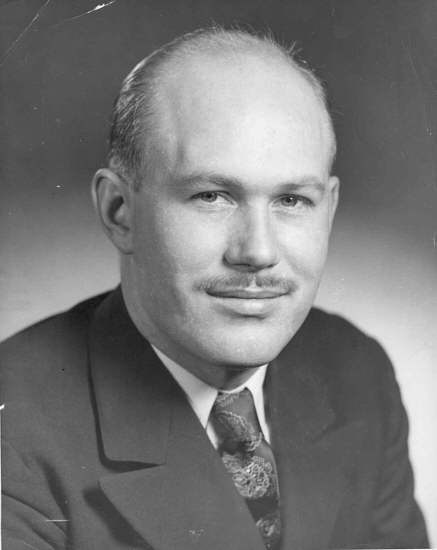 01 Clyde Lee Jenkins
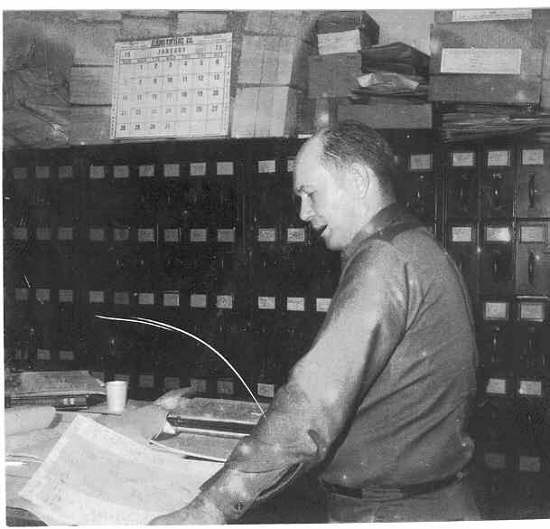 02 Clyde Lee in Clerk's office
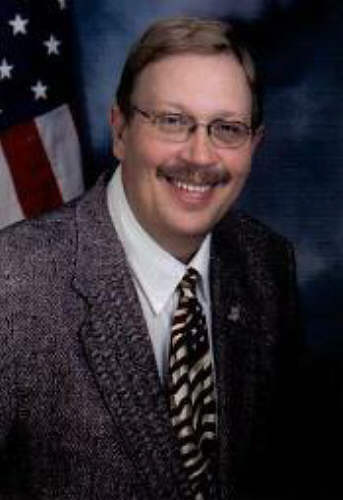 03 Clayton Jenkins "Clyde Lee was such an interesting man and instructed me in Miller County research many years ago. He was County Clerk at the time and received many letters of inquiry from various folks all over the country. I would go into his office and he would say, "Peggy, if you have time to answer them, I have lots of mail about Miller County kinfolks". Through him and his 'fans', I came to know many interesting folks across America ! ! ! Clyde Lee was a fine gentleman and it was my pleasure to know him.......His grandparents lived in Saline township during the census of 1900.....they were the only Jenkins family living there. The rest of the families lived in Jim Henry township near Marys Home. That's where my ancestors lived after coming to Miller County from East Tennessee in the 1830s...........
His grandparents were John H. G. and Augusta Jenkins. John was several years older than Augusta and they had 7 children in their home in 1900 including: CHARLES O. b. 1871; OTIS b. 1879; INGRAM D.((Dwight) b. 1881 (Clyde's father); RAPHAEL D. b. 1885; LOIS E. b. 1887; CLAUDE S. b. 1891; and JOHN A. b. 1892. According to the census records they had 3 children deceased by 1900. John Jenkins was born in Tennessee in 1836 and his wife, Augusta, was born in Illinois in 1853."
Thanks Peggy!
Clyde had a love of the county from which he came and had roots. According to Clayton Jenkins, Clyde's son, Clyde's great great grandfather was named Valentine Jenkins. Clayton believes that Valentine and his son John Henry came to Missouri from Tennessee in the 1850's settling in Cole County. But John Henry later moved a short distance south to a farm located a few miles west of Eugene which was located in Miller County. It was on this farm in 1919 that Clyde Lee was born. Also born there were Clyde's father, Ingram Dwight Jenkins, and Clyde Lee's son, Clayton. The original home is still standing (photo 04).
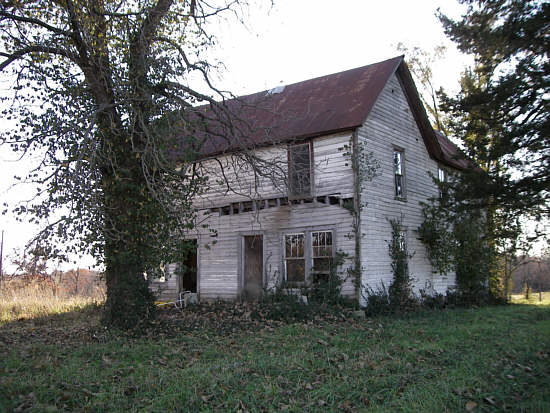 04 Jenkins original Home Clyde Lee went to school at Eugene after which he served in the U.S. Navy during WW II (photo 05) having been on the U.S. Argonne December 7, 1941 when the Japanese bombed Pearl Harbor. Returning home after the war Clyde Lee was able to use the radio and electronics training he obtained in the Navy to set up his own radio repair shop (photo 06). He was the first in Miller County to have a television set. Later, he served the county and area as a State Representative for eight years following which he ran for office and won the election to serve as Miller County Clerk, a position he held until his death.
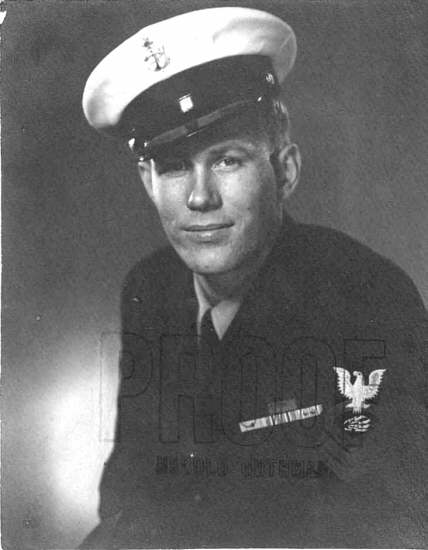 05 Clyde Lee in Navy
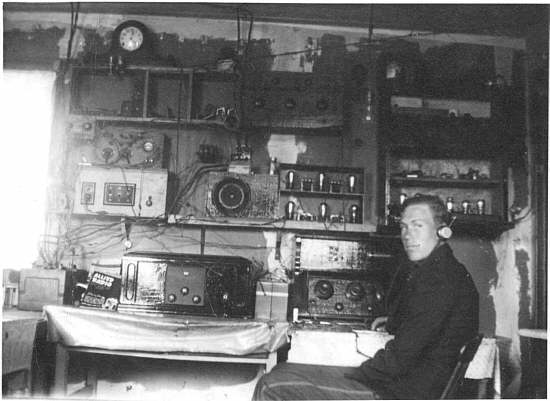 06 Clyde's radio shop Clyde Lee began his research work about Miller County history in the late 1940's and worked obsessively at the project for some thirty years before publishing Volume I which covered Miller County history up to the Civil War. (photo 07) The second volume was completed in the mid 1990's covering Miller County history after the Civil War.
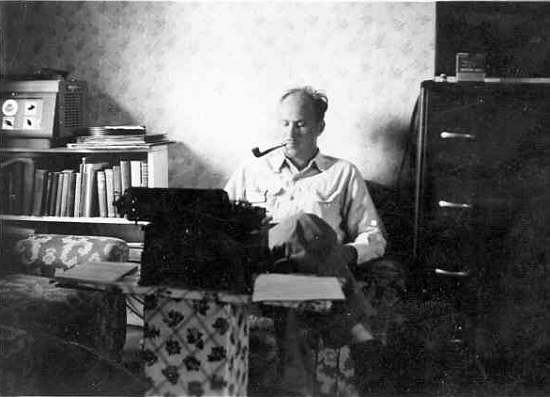 07 Clyde Lee writing Miller County History Clyde Lee was a very interesting and personable man with many interests. He played banjo in a local country band and was active in the County Fox Hunter's Association. (photo 08) He involved himself in many community activities and was a devout Christian. Clifford Hill, who played fiddle in the country band with Clyde, says that Clyde Lee had his own way of playing the banjo; it wasn't exactly Scruggs three finger picking or frailing or clawhammer; "It was just Clyde's style and it was good" according to Clifford. Pauline (Bittle) Jenkins, Clyde Lee's wife (photo 08a), told me that Clyde started picking the banjo at age sixteen and that he was self taught, learning mostly just by playing the way he liked best.
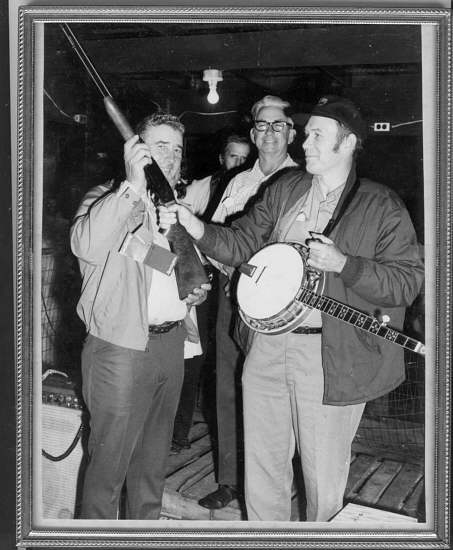 08 Fox Hunter's association John Pendleton, Clyde, Virgil Clark
 08a Pauline Bittle Jenkins Clyde and Pauline lived most of the last twenty five years in Tuscumbia because he had been reelected so many times to the position of County Clerk. Sadly, he passed away suddenly of a heart attack in 1998 at the 78, only a short time after the completion of the second volume of his History of Miller County. But his son Clayton has carried on his father's work by campaigning and winning himself the position his father had held for so many years as the Clerk of Miller County. Clyde Lee Jenkins' life was an exemplary example of those people who give themselves to pubic service and community. Especially will he be honored because of his life work of documenting the history of our county in a style that lent itself well to research as well as entertaining reading.
Jody Newman stopped by last week to deliver us a friendship quilt that was being donated by Belvia Cooper. The quilt was made by the Ulman WPFA in the 1940's and is essentially like new and quite lovely. Bill Cooper, Belvia's son, provided a partial list of the women who worked on the quilt and they included Della Coan (Belvia's grandmother), Ruth Patterson, Minnie Patterson, Nita Patterson, Amanda Graves, Gertie Wyrick, and Leaetta Graham. Belvia was the youngest member of the club and won ownership of the quilt by raffle.
Belvia's Grandmother's maiden name was Luna Adele Van Wagnen. She was born near Ulman in 1867. Her parents came to MO from Indiana in a wagon pulled by oxen. She married a Miller CO man whose parents had come to Miller County from Sandgate, VT.
Belvia has had a recent health set-back and is temporarily living at the Miller County Care Center while she is undergoing rehab. Jody says she has many interesting stories about the Ulman community. Bill Cooper, Belvia's son, brought the quilt over to the Care Center and took a photograph of his mother with the quilt spread across her bed (photo 09). We are very grateful to receive the quilt and thank Belvia and Bill for the gift to the museum and we thank Jody Newman for delivering it to us.
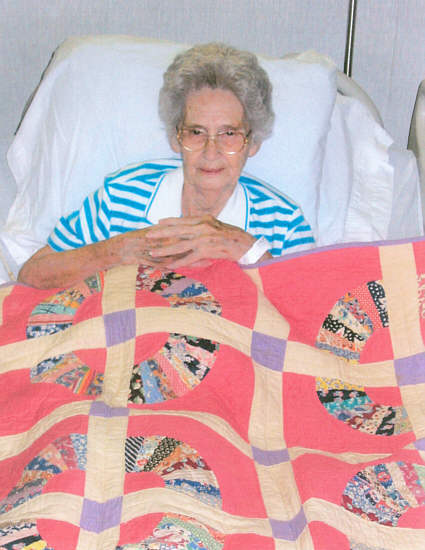 09 Belvia Cooper
Last week Arthur and David talked about the McGowan brother shootout in Tuscumbia. This week they begin the discussion talking about their grandfather, David Christian Bear (photo 10). The interesting aspect of the conversation is that on the one hand, David C. Bear was a hard working Christian man who had served the community well. But on the other hand, he, like his brothers, enjoyed fighting as a form of recreation. Apparently, most of the other men in town did too. The amazing thing is how they seemed to be able to quit at just the right time to avoid (usually) killing each other. In Tuscumbia, according to Arthur, at one time three bars were located along the river bank between the Hauenstein General Store and the Anchor Milling Company. The road between the two became known as "Crackerneck". No definitive explanation how this name was derived is known; however, many feel it was related to all the fighting which took place on Saturday nights along the roadway outside (and inside) the bars. A small jail was built on the bank of the Osage River about the middle of Crackerneck to hold the most violent drunks until they were more sober (photo 11).
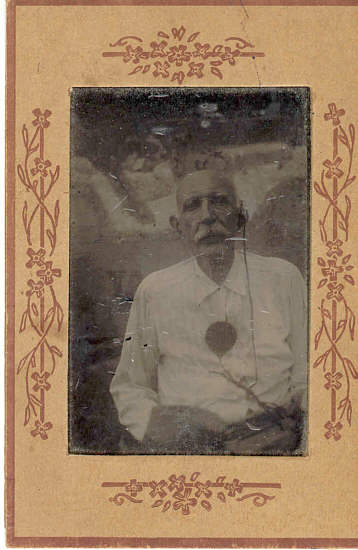 10 David C. Bear
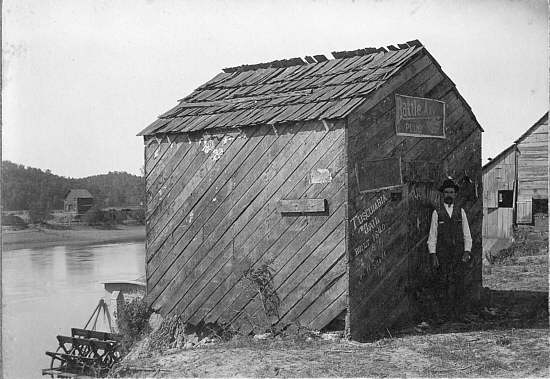 11 Tuscumbia Jail built 1840
Arthur and David
David: Arthur, why don't you start and tell us some
of your earliest remembrances of Grandpa?
Arthur: Well, he was a good grandfather. I can remember,
that as a young boy, he would take me fishing down in Dog Creek, and at times, we would catch a lot of fish. There were big holes of water there then which are now filled up with gravel. We caught a lot of fish. He enjoyed it and I did, too.
Another thing I can remember is that he was an ardent Christian. He attended the Mt. Zion Christian Church and always sat up in the Amen corner along with several other old men. The service was always filled with "amens" when the preacher said something that impressed them. He often lead in prayer. He was a man of high integrity. Evidently, he had been a hard worker, but when I knew him, his hard working days were over.
David: He sported around a great deal with the kids. I believe, Arthur, that you broke one of his ribs one day while sparring around with him.
Arthur: Yeah! He was always wanting to spar with me and he
was good. He was eighty years old at the time, but he was a
good man physically. Quite often he would come around and put up his fists and dare me to hit him. Well, I would flail away at him. He would always throw up a forearm or an elbow which I would hit and hurt my knuckles. That would infuriate me and I would dive into him harder, but I couldn't hit him. We would finally stop and he would tell me, "I am going to hit you right there in the middle of your chest." We would maneuver around and before long in would come his fist and hit me right in the chest. One time, out of all the times I tried to hit him, I got lucky and hit him in the chest and broke one of his ribs. Even though it hurt him, he thought it was funny. He could laugh at his own mistakes.
David: Shame on you, picking on an old man.
Arthur: Yeah, he was 80 years old but he didn't act like one.
David: How is an 80-year old supposed to act?
Arthur: Well! Not as agile as he was.
David: Okay, give us some of his physical characteristics.
Arthur: Well! I heard him say lots of times that he was five
feet and ten inches tall and weighed 170 pounds. He was of normal build, not too fat and not too lean. As he got older he got bald headed like the rest of the Bears
David: Five feet ten was a pretty good height for his day.
Today it wouldn't mean much. Those old Bears grew up under conditions that made them tough physical specimens. They could fight and work hard and were rugged individuals, more so than kids growing up today. More so than kids that grew up in my generation.
Arthur: They fought for recreation. They didn't have to be
angry to fight.
David: Well, they didn't have radio, T.V. or movies for
entertainment. They created their own excitement.
Arthur: Yeah, they would go to town, and especially on
Saturday, there would be a whole bunch of people there. At
times like this there was always somebody looking for a fight. Usually someone would take up the challenge. Often several people might enter into the encounter. People who had a reputation for being tough always wanted to uphold their reputation, and others wanted to beat them. Some of the Bears engaged in these activities, especially Absolom, George, and Andrew (photos 12, 13, 14).
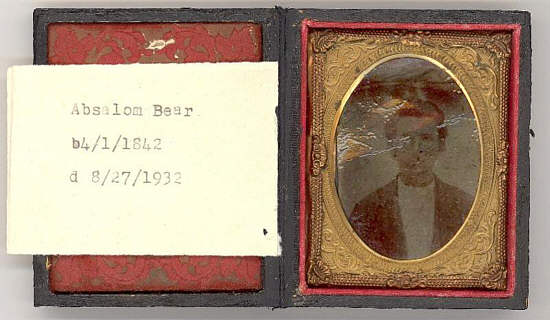 12 Absolom Bear
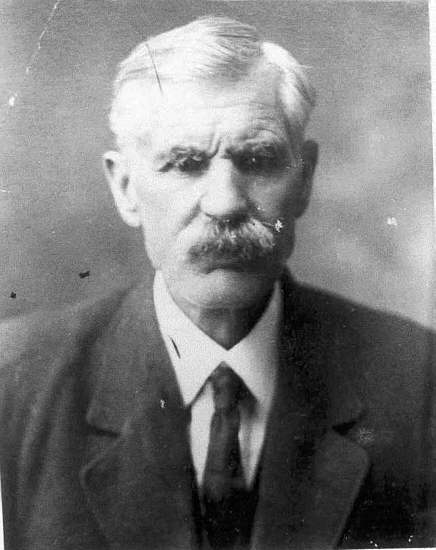 13 George Bear Jr.
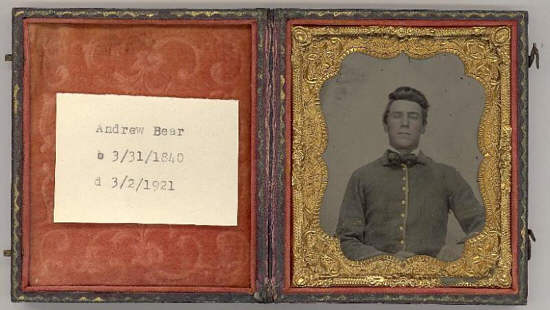 14 Andrew Bear David: The fighting usually started after a few belts of liquor
to provide courage.
Arthur: Grandpa told me about a man in Tuscumbia named John Fogelman (photo 15). (Note: this is the same John Fogleman mentioned below in the reference to the Fogleman genealogy by Ann Rea) He was a huge German who challenged Uncle Absolom one day and wanted to wrestle him. Uncle Ab said, "No I won't wrestle you, but I'll fight you. I know your game. You want to see if you can get me down and then you would whip me. So, there'll be no wrestling, but I'll fight you. We'll do our fighting standing up." Fogelman knew that Uncle Ab was too much for him in bare knuckle fighting, so I don't think the fight ever took place.
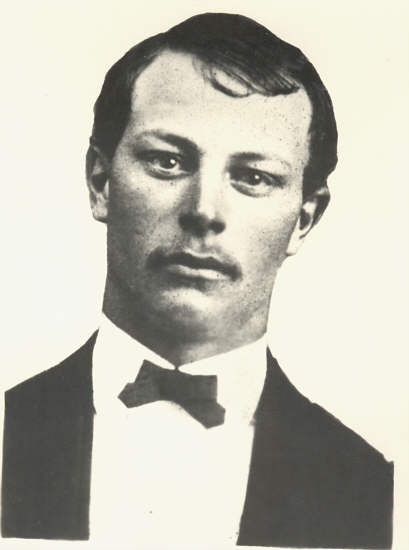 15 John Wilson Fogleman David: Evidently, Absolom was quite a fighter. His height
was well over six feet, and he was unusually big through the
arms, shoulders, and neck. His arms were long enough that he had a long reach. From all the stories I heard, he was never bested. There was nobody around who could whip him in a bare knuckfe fight. Of course, all the stories came through the Bears. They were a tough bunch. Not all of them were as big or as strong as Absolom. George was also very adept. They all tended to hold together if any gang fighting developed.
Arthur: Yes, they did. George was a little bigger than Absolom. He wasn't as tall, but he was a powerful man, too.
David: So I have heard. Andrew was quite a bit smaller, but
I guess was a pretty good scrapper for a small man. He was
an agitator. He was good at getting a fight started for Absolom and George. I remember a story that Grandpa told once about an incident that happened in Tuscumbia on a Saturday. In those days, a small town was the social center. Transportation was by walking, riding horseback or going in a wagon. The automobile hadn't arrived yet, so there was no going to Eldon or Jefferson City. Saturdays were for trading, visiting and sport. Grandpa said that up on top of the river bank was a saloon, and the ground on the outside of the building was called the "butchering" grounds. That is where they usually congregated to fight. One day, Uncle Andrew was there under the influence of liquor, and he yelled out, "I can whip anybody here." A man name Mike Curry heard him and said, "What did you say Andrew?" Andrew repeated it, so Mike made a move toward Andrew and Grandpa said, "I just happened to be standing between the two, and I guess Mike thought that I should move out of his way, so he started moving right through me. I let him have a punch right between the eyes and Mike went down. He got up and started after me with a knife, so I picked up a double-tree off the ground (that is part of a wagon's hitchup and was a large piece of wood) and I felt myself going up on my toes to deliver a blow against a man who was after me with a knife. Mike wasn't so drunk that he couldn't see the folly of his ways, so he changed his mind and retreated."
David: What has been described was typical of what went on. Sometimes another community would be the scene of action where the fighting would occur such as Capps, Charley Town, (now known as St. Elizabeth), Iberia, Ulman or Brumley. I don't know that the Bears went to all these places, but they did move around. All the small towns were very similar. Now, think about it, if you didn't have entertainment like we have today, you would create some of your own. Physical prowess was something that people were proud of, especially if they were good at it. But to not accept a challenge could brand a person as a coward.
These activities, as described created a lot of community
interest. Arthur, what else do you want to say on this topic?
Arthur: As you say, these activities were helped along by
liquor. The young people learned early in life to drink it.
Grandpa told me once that back in that period, it was not safe for a woman to walk down the streets of Tuscumbia alone because of the drunks.
David: I have heard that Grandpa didn't drink liquor like the
others. I don't know if it was against his principles or whether
he was one of those people who couldn't handle it. At least
he learned quite early in life not to use much of it. In
addition to imbibing for pleasure, they all thought that liquor
was very good medicine, so there was a lot of sickness (a few har hars here). Those were the days before prohibition and heavy liquor taxes, so I guess many people made their own or got it from someone who did. There was never a shortage.
Arthur: I don't know where they got it, either, but at that
time it was legal. One day Uncle George and Uncle Ab were down at St. Elizabeth attending a picnic. Maybe Grandpa was present, but I am not sure. Liquor was always a part of the celebrations and this always brought out the rowdy behavior in people. It also gave courage to those who wanted to whip somebody to improve his reputation as a fighter. Since the Bear boys had a reputation as fighters, the sheriff, Kellis Martin, and several others decided to pick a fight with them. The fight got started, and one of them used a knife on George and put him out of the fight. Uncle Ab knocked the sheriff to the floor and then put his foot on his neck to hold him down while he dealt with the others. Finally Uncle Ab looked down at the sheriff and saw that he was turning blue in the face from lack of air. This caused concern from all present and the fight wound down.
David: Yeah! Well, they had a lot of stories like that, and
our cousin, Frank Martin, knew all of them, but he is not with
us anymore to refresh our memories. Many of the stories centered around uncle Ab (photo 16). Many people wanted to whip him, but those who tried were unsuccessful.
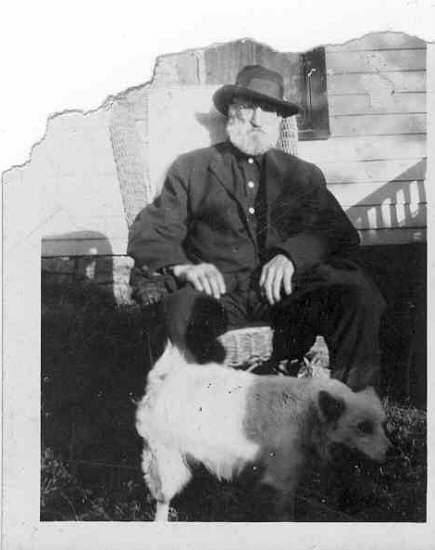 16 Absolom Bear when elderly Thanks Arthur and David
The Fogleman family (Ruby, Pauline, and Lillian) has provided our museum with quite a lot of family history pertaining to their Fogleman heritage, and in particular as it related to their grandfather, John Fogleman (photo 15 above), who was a blacksmith and livery owner in Tuscumbia in late 1800's. John was born in Illinois but came to Miller County in the mid 1800's. One of the members of the family, Ann Rea, has written an extensive family history of the Foglemans' as well as others in the family's extended genealogy. This genealogy has been donated to our research library by the Fogleman family. However, the introduction to that research work I found very interesting because it gives some history as to what were the circumstances which brought a number of families of German origin to our area. The following is a portion of what Ms. Rea wrote:
"The Foglemans migrated to America between 1725 and 1750. The original German spelling of the name was Vogelmann. They were among thousands of German protestants migrating during the seventeenth and eighteenth centuries. Most of these immigrants came from the upper Rhine valley in the Palatinate, which is the modern German state Pfalz-Rhein. This district was claimed by two Catholic countries, France and Prussia, so it was a battleground between the countries for many years. During the Thirty years war 2/3 of the population disappeared and 5/6 of the villages were destroyed.
Many Palatines decided that the hardships of the Atlantic voyage and frontier life were preferable to the constant slaughter, torture, and destruction of property they experienced at home.
Lutherans were better off than others in that the peace
of Augsburg of 1555 and the Treaty of Westphalia in 1648 recognized their religion. The German Calvinists (or German Reformed), Moravians, and pietist sects such as the Amish found life in Europe even more difficult. In Alsace-Lorraine, the provinces between Germany and France, people emigrated because catholic Louis XIV of France wanted to take the area from protestant Germany and extend his boundary to the Rhine; every ten years he conducted a war in the area.
The emigrants began their trip by traveling down the Rhine River to Holland, where they embarked on British ships to America. Most often, their destinations were Pennsylvania and the Carolinas. Their choice of Pennsylvania was not accidental. William Penn offered religious freedom to all Christians; at the same time he wanted stable, industrious settlers in his colony. He wrote glowing articles about his province, had them translated into German. Dutch, and French, and distributed them throughout the Rhineland. Further, in 1709 the English Parliament passed a naturalization act which permitted foreign Protestants
to come to the English colonies and become English citizens.
As soon as they landed in Philadelphia, the men were taken to the old state house (now Independence Hall) where they took part in a ceremony in which they took an oath of allegiance to the English Crown and the province of Pennsylvania and were granted citizenship.
Most of the German immigrants settled in Berks, Bucks, and Lancaster Counties, where they became known as Pennsylvania Dutch. Some moved further west. Some moved to North Carolina; Melchior Fogleman was among these.
The Carolina proprietors welcomed Germans for the same reasons Penn did, so western North Carolina had many German settlers. They traveled from Pennsylvania to North Carolina along what was known as the Great Wagon Road, across the Susquehanna and the Potomac and down the Shenandoah Valley, roughly along the path of present day highways 81 and 29.
Much later emigrants such as Wilhelm Hauenstein (photo 17) and Johann Valentine Kallenbach (photo 17a) came to America and eventually Miller County around 1850 as part of another large wave of German migration. Dissatisfaction with the autocratic German government culminated in the unsuccessful revolution of 1848, when migration escalated for several years. These emigrants settled primarily in Missouri and Wisconsin."
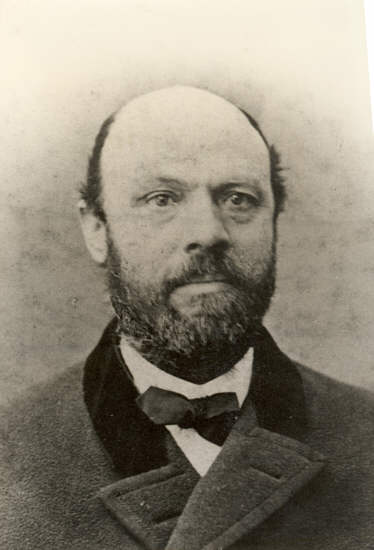 17 William Hauenstein Sr. 1822-1913
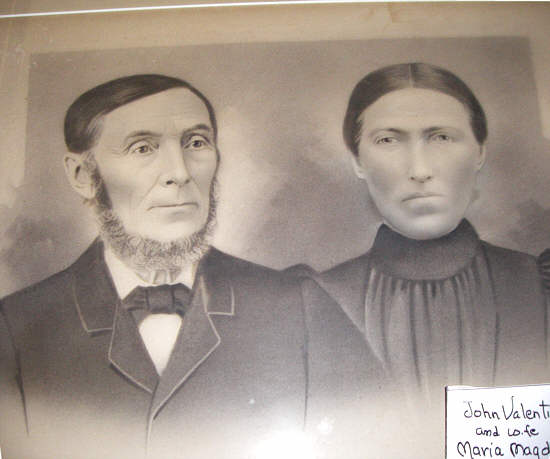 17a Johann Valentine Kallenbach and wife Maria
The last in our series about the cedar novelty industry of the Lake of the Ozarks area summarizes the story of the Blair Company in Camdenton (photo 18). Part of the narrative was written several years ago by Mrs. Ralph Blair and another portion was taken from Lifestyles/50, a monthly periodical which was published in February of 1993:
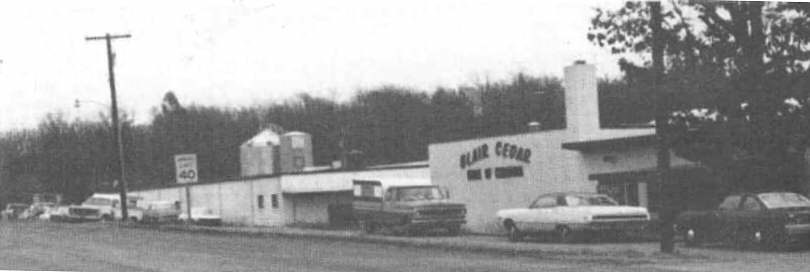 18 Blair Cedar and Novelty Works Inc Blair Cedar and Novelty Works
Mrs. Ralph Blair (Lake of the Ozarks 1981 Union Electric Company)
Lifestyles/50; February, 1993, page 18
In 1930, when the Lake of the Ozarks was in its infancy, John Blair (photo 19) of Reeds Spring, Missouri moved to the site of what is now the City of Camdenton, along with his wife, Ova and their seven sons: E. W., Ralph, C. C., John, Jr., Glen, Donald and Leslie. John was supervising the construction of Highways 54 and 5, the intersection of which marked the site destined to be the new county seat town of Camdenton.
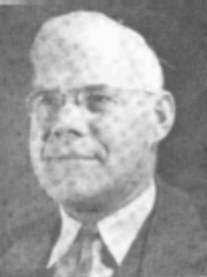 19 John Blair Deciding to make Camdenton their permanent home, the
Blairs bought some land and in March 1935 they opened Blair Hotel and Cafe. John had used native red cedar to wainscot the interior of the building and using hand tools had made cedar counters, tables and chairs for the cafe.
In 1937 John set up a small woodworking shop in the hotel
basement and using cedar fence posts and scrap lumber he started turning out small souvenir items, selling them in the cafe. The popularity of the items made from the colorful aromatic cedar grew rapidly and shortly after the war was over the hotel was sold and full time was given to the new business.
Without realizing the magnitude of it, John Blair had become the founder of BLAIR CEDAR & NOVELTY WORKS, INC.
the largest cedar souvenir manufacturing company in the United States. The beginning was slow. Each item had to be hand sanded, hand finished with coats of shellac and spar varnish and the souvenir marking was hand printed also.
John started regular sales routes in Missouri and Arkansas, first putting the novelties out on consignment. Ova took care of the office and packing and Ralph managed the shop, which by now had outgrown the hotel basement. Needing more time for development, John took Ralph in as a partner and let him take over the sales routes. (Ralph later gave up his partnership because of his church ministry, and E. W., C. C., John and Glen formed a corporation with their father).
Due to gas rationing during the war, the catalog-mail order
business was introduced and soon Blair Cedar became known nationwide.
The inevitable "growing pains" developed and soon after the
boys came home from the war, extensive expansion programs became necessary. In 1953, after several fires, the plant was moved to its present location on West Highway 54.
John retired in 1959 but kept active in his machine shop until
his death in August 1971 at the age of 82 years.
As time progressed the company continued to grow and expand. Labor costs increased but the pubic continued buying the unique cedar wood souvenirs. Salt and pepper shakers that originally sold for $3.00 per dozen pair, later sold for $16.20 per dozen wholesale, and sales that amounted to $300,000 in 1949, grew to over $5,000,000, by the mid 1990's. The company had a huge selection of items to sell reaching some one thousand cedar items from which customers could select to purchase. Many large stacks of cedar lumber were purchased and stored in drying sheds and later dried in specially made kilns (photo 20).
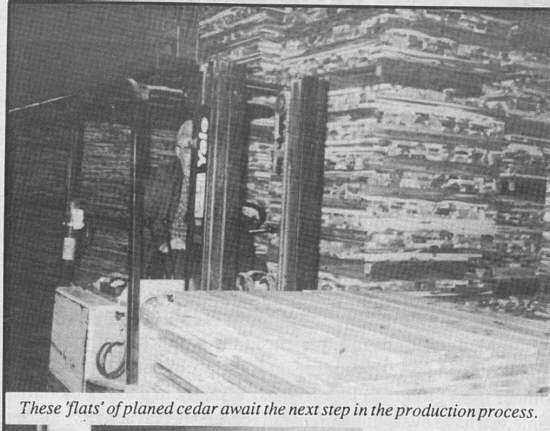 20 flats of cedar lumber Regarding Blair marketing, five salesmen traveled throughout the United States. Items were exhibited at gift shows, and top sellers continued to be the salt and pepper shakers, ash trays, and coin banks. The latest techniques in sawing, sanding, shaping, drilling, and spraying were used, and laser engraving replaced the time honored rubber stamping.
The process of laser engraving involves cedar that is treated in a dry kiln to 150 degrees Fahrenheit, and takes from three to ten days to cure, and is sprayed with a special process lacquer. The laser engraving of today was originally a hand written process by Mrs. Blair. The hand printed designs evolved to printer's press, and now are silk screened.
As it was in 1930, it still holds true that products are designed by the sales and production staff.
Blair Cedar Company in the mid 90's reached an employment figure of eighty five employees. In addition were sixty- five service jobs and Blair's outside suppliers in the local area, in turn employed approximately fifty people year round.
John F. Blair is one of fifteen family members who make up Blair Cedar and novelty, and holds a sales degree from the University of Missouri. His brother, Matt, is controller. The Blair Company has continued to flourish even as the public demand for cedar wood souvenirs has diminished, partly due to the decision many years ago to diversify the product line into many different areas in addition to cedar wood items. Although at one time as many as seven cedar wood novelty companies were located in the Miller County area (Blairs' in Camdenton is the only one of this series outside of Miller County), the Blair and Stanton businesses are the only ones remaining actively producing cedar wood products.
The Red Oak Inn of Tuscumbia (photo 21) owned by Wes and Connie Horton has been mentioned on this page before. It has a central location in the county at the junction of highways 52 and 17 just south of the Osage River. Because it is the only restaurant (with seating) in Tuscumbia it is quite a popular place, especially on days when court is in session at the Court House. Not infrequently I see people dine there who live in Eldon as well as others who live in Iberia. The other day Sam Webster of Eldon was working on laying a cable for the telephone company and he and his crew came over to eat lunch. Also dining for lunch that day were Lewis and Helen Wall of near Iberia. The restaurant is one good place to learn what is going on not just locally but around the county. This week Jack and Richard Lupardus were dining at the restaurant. Jack (who lives near Eugene) had just returned from Branson and accompanying him was his guest who had been appearing on stage there recently. Maybe you will recognize him! (photo 22).
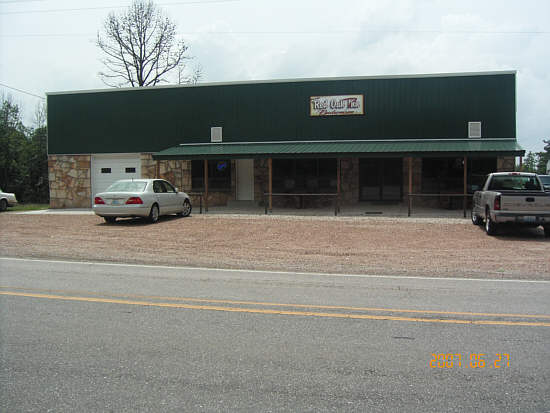 21 Red Oak Inn
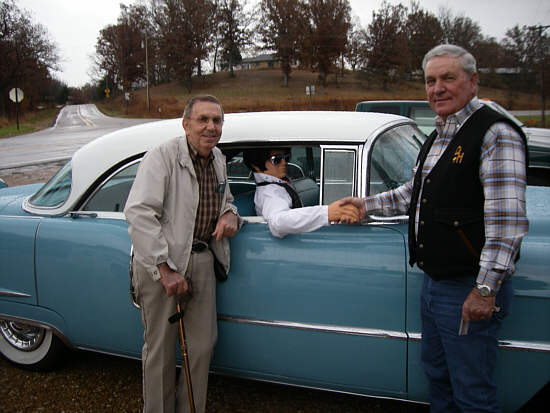 22 Jack and Richard Lupardus with guest
A few years ago Ginny Duffield wrote an article in the Autogram about the old steamboats which used to ply the waters of the Osage River providing one of the main sources of commerce for Miller County. Homer Clay Wright (photo 23) was the last President of the Anchor Milling Company which owned most of the steamboats used on the Osage. I knew Homer well when I was growing up in Tuscumbia as he was a neighbor just a few houses down from my home on highway 52 in Tuscumbia. Homer gave me an old regulator pendulum clock (photo 24) which had belonged to the company for many years. In my senior year in high school at Tuscumbia our class invited Homer to give the address at our graduation ceremony. I still have on eight millimeter movie film a recording of that event in 1961. I also knew well Dewey and Leonard Kallenbach who are others that Ginnie interviewed for this article. So, when I ran across this article in our museum files, nostalgia prompted me to want to share it with the readers of this website. You can read more about the Anchor Milling Company on the page devoted to mills on our own website at:
(http://www.millercountymuseum.org/commerce/milling.html)
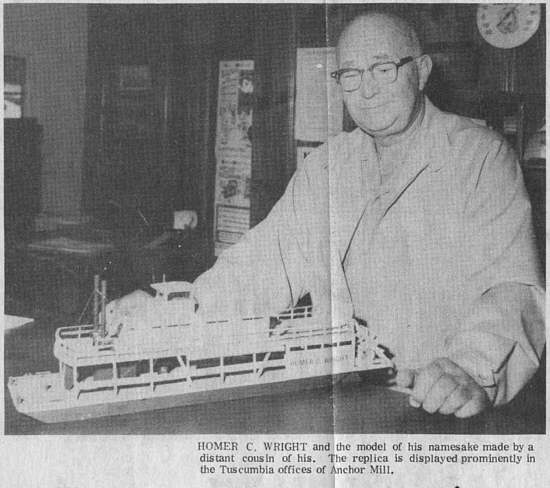 23 Homer Clay Wright
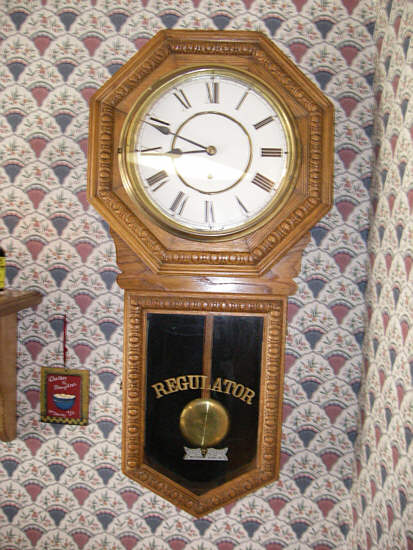 24 Anchor Mill Regulator Clock You will need to scroll down the page a short distance as the mills listed are in alphabetical order.
You can read even more about Osage River Steamboats at another page on our website at:
(http://www.millercountymuseum.org/rivernav.html)
Steamboats:
BY GINNY WHITNEY DUFFIELD
The coming of the railroad and the increase in truck transportation ended the steamboat traffic on the Osage River in the 1920's. There are, however, those who still remember the days when they worked on the river. Tuscumbia was in its heyday with the river traffic. Anchor Milling Co. of Tuscumbia operated its own boats to bring merchandise, produce and livestock in and out of the area. Many of the memories are of those boats.
At $1 day and board, steamboat work had "the best wages
around," Ed Wright of Eldon said. He worked on the river as pilot, cook and deckhand at various times. "It was hard work," he remembers. He said the deck hands sometimes carried sacks of wheat on their shoulders until they were raw. In 1902, the J. R. Wells (photo 25) steamboat delivered 54,000 sacks of wheat to the Missouri Pacific Railroad at Osage City where the Osage River meets the Missouri.
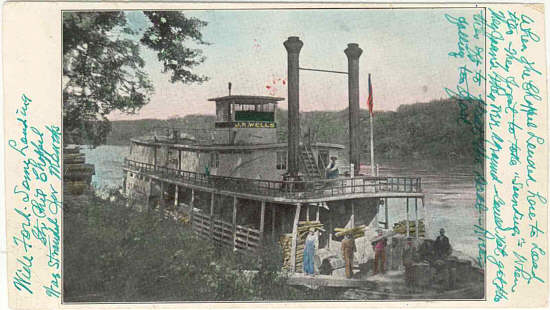 25 J.R. Wells--C.B. Wright above. Below are Ben and William Bear, Charley Greenup, Will Nichols and Aaron Wright Homer C. Wright of Anchor Milling said wheat was not the only thing shipped by boat. "You name it, they hauled it."
Salt, machinery, chickens, hides, tiff, chalk and wood were among items loaded on the boats and their barges. Homer Wright said the last boat on the river and his namesake, the Homer C. Wright (photo 26), could handle "three or four" of the present day carloads or six to eight carloads of that day.
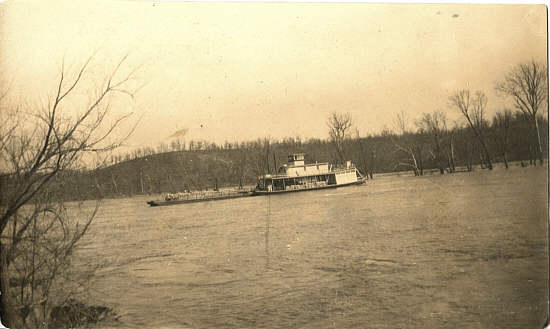 26 Homer C. Wright with load of wheat. Big river Ed Wright can remember when one of the boats was used to
attempt to ferry an elephant across the Osage. He said a traveling show had come through and the elephant would not cross the bridge. "We got him on the barge all right," he said, but the elephant jumped off into the river. Wright said the elephant surfaced under the boat and it rolled off its back. The elephant was gotten across by towing him with the boat, but then the animal could not get out of the river because the bank was too steep. "By that time there was 100 (people) down there," he said. Ropes were brought from the mill and the animal was finally pulled up the bank and sent on its way with nothing more serious than a broken tusk.
Anchor Milling regularly made runs from Linn Creek to points
down river, sometimes as far as St.Louis. Late in 1907 the J. R. Wells made a special trip to Lake Providence, La., to bring back four barges for the Leavenworth Bridge Co. for use in construction of the McKinley Bridge at St. Louis.
Leonard Kallenbach of Tuscumbia said he made several trips on the Ruth, a gasoline powered boat. He said, "It seems to me like it took about 10 days" to get to St. Louis. According to an old picture calendar put out by Anchor Mill, a
round trip took about two weeks with the J. R. Wells.
The famous steamboat whistles were vital to river trade. Kallenbach said farmers would get together and build landings all up and down the river and ship their wheat and livestock from them. When a boat was approaching a
landing it had a load for, it would whistle, Kallenbach said, so the farmers would come get their things. If a farmer wanted a boat to pick up a load he would tie a red flag upriver from his landing and the boat crew would stop and pick it up and whistle they had seen it. And there was always a whistle
for Tuscumbia. "We'd hear the boat whistling way down below where the bridge is now," Mrs. Kallenbach said.
Many of the old landings are gone now. Hoecker, below Henley, was an important one as it was near where the Rock Island tracks crossed the river. The railroad had a spur line down to the landing and provided stockyards. Another landing, Wide Ford, in Camden County, was flooded by the impoundment of the Lake of the Ozarks. It was known for its high banks at the landing and was a few miles below the mouth of the Grand Glaize Creek and Zebra. Capps was used as a landing for the St. Elizabeth area, and old Bagnell was important because it had a railroad. Homer Wright said Jefferson City lawyers with cases in Miller County would take a train to Bagnell and then a boat to Tuscumbia. It was a one-day trip each way, he said.
The boats were also used for excursions. Kallenbach said an
excursion to Bagnell "was a big trip." Both Mrs. Kallenbach and Mrs. Ed Wright remember taking pleasure trips on the boats. The back of the upper deck of the J. R. Wells was outfitted for passengers as were many of the boats.
The Ruth (photo 27) was originally built by Wells as a pleasure craft, Ed Wright said, but was soon used in the river trade.
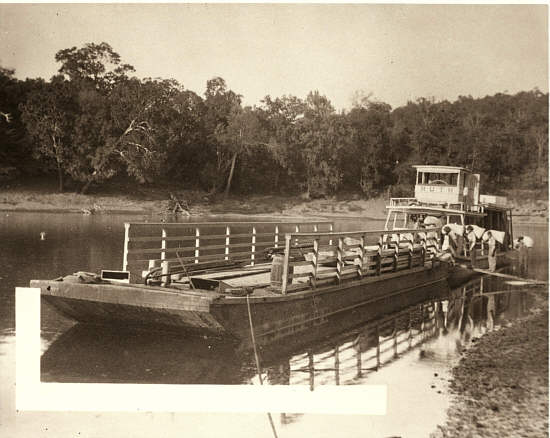 27 The Ruth with barge The steamboats were not only headquartered in Tuscumbia but also were built there. The J. R. Wells was built in 1897
under the supervision of Capt. Phil F, Hauenstein who was also secretary-treasurer of Anchor Milling. The master mechanic was Joseph Shepherd. Her first officers, were John W. Adcock, master and pilot, and Darwin Bennett was
chief engineer. Among the crew pictured in the 1905 photograph of the craft are Ben and William Bear, Charley Greenup, Will Nichols, Aaron Wright and C. B. Wright, Homer Wright's father.
C. B. Wright and Phil Hauenstein built the Homer C. Wright at Tuscumbia. Hauenstein was Homer's grandfather and named the boat after his young grandson." I can remember when the boat was launched," Homer Wright said. Kallenbach said the boat was built down by the garage of the house he now lives in. The mill was down thre, too."It hit the water in 1919," Wright remembers. When the ship was commissioned "boating was pretty well out," he said. In 1923 or so the boat was sold to Union Electric for use as a ferry when the Cahokia electric plant was built near St. Louis.
The J. R. Wells had been sold in 1909 for use on the Missouri River. Reports have it the boat sank in an ice jam near St. Charles in 1920 or 1921.
Most of the steamboats were named for someone, The Wells' barge, Ida, was named for Hauenstein's daughter, Mrs, B. H. Hicks of Tuscumbia, The Ruth was named by placing all of the J. R, Wells' daughters' names on pieces of
paper and drawing one out of a hat, Kallenbach said.
When steamboat traffic stopped on the Osage, it was 86 years old on that river. The year 1837 was the first for steamboats on the river, and C, p, Davidson had the first ferry at Tuscumbia that year.
J.H.C. Branham was the first Miller Countian to own a steamboat with his half interest in the Chouteau Belle. In 1858 Samuel Short of Iberia owned half of the Belle.
Ed Wright thinks his river days were his best days. If he could he said, "I'd go do it again."
Continuing with this discussion of the steamboats originating in Tuscumbia, I found this submission made by Homer Clay Wright to the Autogram years ago (the date is not on the copy of the article I have) which was written by Homer's father, C.B. Wright. The article is introduced by Homer as follows:
"The Steamer J, R, Wells was the finest boat to ply the Osage river for any length of time. She was built by Anchor Milling Company in 1898 and sold to operate on the Missouri river in 1919. Here are some excerpts from my dad's writing about the Wells:"
J.R. Wells by C.B. Wright (photo 28)
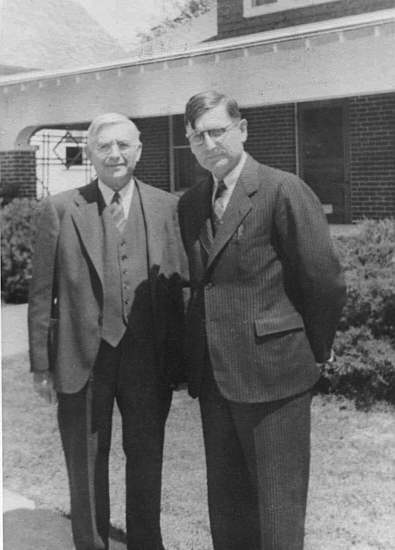 28 CB and Tennyson Wright The Anchor Milling Company was incorporated in 1897 with J.R. Wells as president and P.F. Hauenstein as secretary and treasurer, Soon afterward the directors decided that the corporation should have a steam boat since the company had a good flour business at Zebra and Linn Creek, A. J, Watson at Linn Creek was a heavy buyer, his orders averaging 20,000 pounds. The steamboat was built in Tuscumbia by ship carpenter Joe Shepherd of St, Louis who had built the Fredrick. The boat was named "J.R.Wells" after the President of the Company. The best timber to be had was put into the boat, The hull, except for the bottom, was all oak, The bottom was native pecan, and incidentally, when inspectors checked it years later after the mill had sold her, they found places only three to four inch thick, having worn down from two inches or more. The Wells was 20 feet wide and 100 feet long. Her boiler was allowed 155 pounds of steam and she was not difficult to fire. The main fuel was
wood but a little coal was used. The mill and boat used about 400 cords of wood per year which was purchased for $1.35 per cord. The steamboat was built and got her first inspection in April of 1898. Her first papers were signed by Gordon and Core, United States local inspectors at St. Louis. The Wells was well built; she had good engines 10 x
48, of the slide valve type. The boiler fired well, that is, did not use more fuel than one would expect. A steamboat engineer enjoys seeing the engine perform. A 48-inch stroke means eight foot traveled for each piston for every revolution of the wheel. It was found that the Well's stern wheel was too
small and a larger wheel was built in the winter of 1898 which proved just right.
John W. Adcock was pilot and master of the Wells, and
Darwin Bennett was chief engineer. Pilots are restricted
as to territory and size of boats. All boats are measured
in tons. The Wells was rated, when new, at 130 tons but was
later re-measured and rated at 100 tons. Engineers are licensed as to tonnage. Large boats have mates and they are also licensed. Henry L. Zibetin of New Haven worked on the Wells as first mate. The duty of a mate is to take charge of the crew and to load the cargo.
The idea of building a boat was to better serve our trade;
that is, to distribute flour and lumber and bring in lumber
and other items for sale in our business and to handle wheat
and lumber going out. The J. S. Sullivan Saddle Tree Company was located in the state prison and bought sycamore lumber four to six inches thick and
eight to 16 inches wide. A boat load of this lumber would consist of 40,000 to 50,000 feet. On one trip a raft of 30,000 feet was taken out of the water at Zebra.
The author remembers one load of 60,000 feet loaded a
quarter of a mile up the Big Tavern Creek. It was wheat
that made the bulk of the downriver cargo. The Wells
made plenty of trips with 2,000 sacks of wheat down the
Osage. In 1902, the total amount of wheat handled was a
little over 54,000 sacks, all unloaded at Osage City.
Mention has been made of A.J. Watson of Linn Creek. He
was in the tie business in a bigway and had a large general
merchandise store. On one trip to Linn Creek we had a car of salt, car of wagons, car of cultivators and a car of corn
planters. He would average a car of wagons a year and
bought furniture in car lots. Watson sold Oliver plows and a
time or two had straight car loads of plow points. On my
first trip on the Wells to Linn Creek we were carrying 200
cases of beer.
The last time I saw the Wells was in 1919. Captain Phil and I
were on our way to Hermann by rail and saw the Wells tied
up in the Gasconade River. Later that day we came back
and looked the old boat over. Having been built in 1898 she
was then 21 years old.
Not long after that the good steamer Wells was cut down by ice some distance above St. Charles at Pelican Bend.
Thanks C.B. and Homer
As a conclusion to the series of stories this week about the Osage River steamboats, I have this article from the Autogram written more than twenty years ago by Carolyn (Patterson) Pryor in which Carolyn describes one of the last trips made on the Osage for the purpose of carrying heavy freight. Carolyn is married to my cousin Max Pryor and was a writer for several years for the Autogram. The Aldyth (Bottoms) Vaughan mentioned near the end of the article was one of the area's best cake makers.
Barge on the Osage
Carolyn Pryor
Today it is very hard for residents of Tuscumbia and outer lying areas along the Osage River to comprehend
how busy it was with traffic of boats of various kinds, dating very far back into history. Once a busy river, in recent years
the Osage has become frayed and forgotten as to how beneficial it was, partly due to modern technology and
improved roadways. But families who worked on the
river in years past and devoted readers of "The diary of C,B,
Wright" know how bustling the Osage was in years gone by.
However, near the boat ramp access in Tuscumbia last Thursday morning, early risers could have caught a glimpse of six persons braving the cold temperatures and eagerly gazing up the Osage River. They were there awaiting their first eye contact of a pontoon section barge being pushed by a tugboat down from Bagnell Dam (photo 29). They were aware that starting time was 7:15 a.m. and it was traveling at 10 miles per hour, drawing fout feet of water. Still they didn't know how long it would take to make the 15.7-mile trip by waterway on the Osage River.
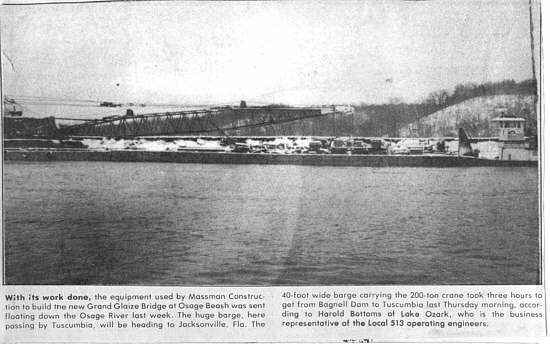 29 Last Barge on the Osage It arrived at the first bend from the ramp at 10:15 a.m. making it a three hour ride for a crane operator and
tugboat operator, both out of St, Louis, and a mechanic for Massman Construction Company out of Springfield.
They were hauling a crane, one of which had been utilized by Massman Construction in building the new Grand Glaize Bridge (known by history buffs as Zebra, the name of the location before the now older bridge was built), making the load 200 tons on the 40 foot wide barge. They were en route to the Lock and Dam passage way at Osage City, 13 miles southeast of Jefferson City. There it was to be reloaded and taken over by a larger tow boat which could take it down the Missouri river to the Mississippi river on to its destination
in Jacksonville, Fla.
The reason the unusual route was chosen was that it was more expedient, safer and economical than highway transportation, and Union Electric cooperated fully as the barge put in at Bagnell Dam.
Back in the mid 1930s, the late Kelly Bottoms was a government overseer of the dredge boats on the Osage
River, making sure that the riverway was passable for the many barges carrying goods and other boats, some for business purposes and some for pleasure. He and his workers lived while working on a river houseboat, which was their home away from home.
It was quite a busy job, which employed many at that time, two of them being among the spectators Iast week: a son, Roy Bottoms of Barnett, and a son-in-law, Robert (Bob) Vaughan, Tuscumbia.
Mr. Bottoms was accompanied by his wife and their son, Harold Bottoms of Lake Ozark, a business representative of the local 513 Operating Engineers (construction company hoist engineers), who along with his fellow worker, Kenny Murphy, and Mrs. Vaughan, the former Aldyth Bottoms, daughter of the late Kelly Bottoms, recounted many happy memories.
The company plans two more such trips of equipment, moving cranes from the new Grand Glaize Bridge to where the Larry Don excursion boat is located, then hoisting them over Bagnell Dam and launching just below the dam.
Ironically, Osage River banks patiently endure their arrival as they must have done years ago.
A few years ago the Miller County Courthouse offices were moved to a new courthouse building on highway 52. The previous courthouse, which was built about 1910 (photo 30), was sold at auction two years ago to Ron Helton (photo 31) of Tuscumbia. The purchase included the old jail (photo 32) which was located on the same piece of property. Both buildings have a southern view overlooking the Osage River far down in the valley below. Nancy Thompson, museum director, and I visited Ron the other day to see how things were moving along. I was really impressed with all he has accomplished. Ron has been working steadily over the last two years to renovate the jail house, a mission which has been time consuming and not inexpensive. However, Ron has made significant progress in areas such as stripping the walls, putting in a central heating and cooling system and new plumbing for bathrooms, polishing door and window handles, and strengthening the column supports for the large overhanging porch roof. He plans to live in the upper floor of the jail house while he renovates the old courthouse next door. Ron has many skills which lend themselves to this type of work. His background was in concrete foundation and flatwork construction projects which he learned from his father Bennett Helton, who along with partner Ronald Clement, owns the Alpha Company which specializes in this type of work. In fact, Alpha Company did the concrete work for our new museum addition. Presently, Ron is working for himself on call to various construction projects so that in between jobs he can have time to devote himself to his passion of preserving the old jail and courthouse. He, like many others, does not want to see these two very historic buildings deteriorate and over time eventually crumble to the ground. Eventually, Ron plans to support his work by converting the two buildings to "mini hotels" including a restaurant for vacationers who come to the Lake area. Part of his vision includes using the old court room of the second floor of the courthouse as an entertainment area for plays and musical productions (photo 33). We wish Ron well in his endeavors because we, as much as anyone, being involved with preservation of historical objects and items having to do with Miller County at the museum, have a profound desire to see him succeed.
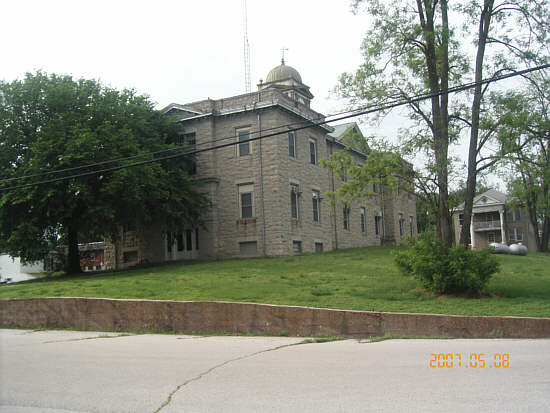 30 Third Miller County Courthouse and Jail
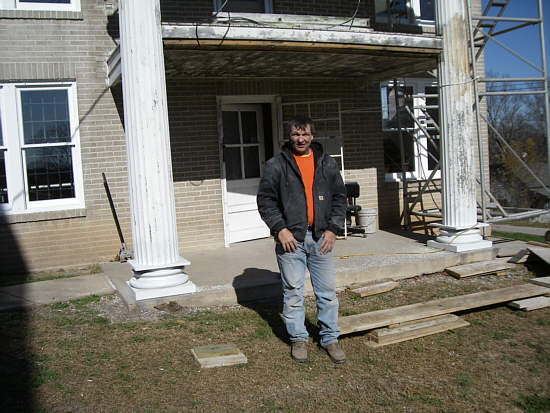 31 Ron Helton
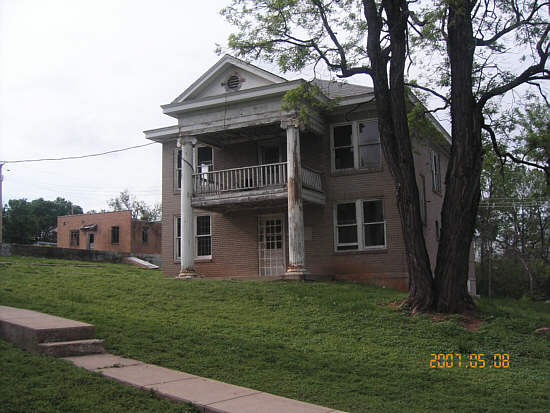 32 Old Jail
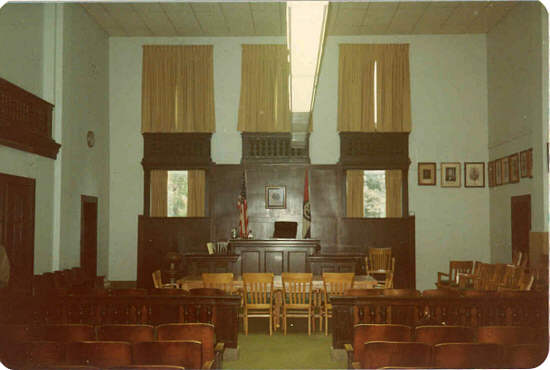 33 Courthouse Courtroom Several years ago Peggy Hake summarized the history of the Miller County Courthouse. That summary is presented here:
Peggy Hake
The Miller County Courthouse
The first building used as Miller County's courthouse was
a small structure, constructed of logs, 35 ft. X 20 ft. in size (photo 34).
The old courthouse had two rooms and was roofed with bur
oak shingles with a side door and a front door. The log
building had a stone chimney with a fireplace inside which
was built by William O. Short of Richwoods township. The
year was 1839 and the original courthouse was erected by
John T. Davis, Presiding Judge of the County Court that
year. He submitted a bid for building the courthouse in the
amount of $199.00 and it was accepted. After Judge Davis'
bid was accepted, he turned around and borrowed $75.00
from the County Court so he could begin construction of the
new courthouse immediately! This courthouse was built on
Lot 12 in Block 23 of the original town of Tuscumbia. Later
in 1841, he also built the jail which sat about a block north of
the first courthouse on Lot 12 in Block 10 of the original town
of Tuscumbia. The old jail sat almost directly across the
street from the present Christian Church in Tuscumbia.
Because of the cold wintry weather, a second fireplace was
built in the old courthouse, but it still proved to be so cold
that the County Clerk, William P. Dixon, took all he could
and finally built a small frame building on Village Square
which later became the site of our present courthouse. In
1858, the county court decided anew, more suitable
building was needed for a courthouse and the log building
was replaced by a two-storied brick building (photo 35). It measured 40 ft. by 56 ft. This building was completed in early 1859 and could only be used for political purposes. In the past, the citizens had evidently used the old building as a gathering place for cotillion and dancing parties, singings, preaching and worship services. By 1909, the county court, consisting of David C. Bear, Presiding Judge; J.J. Alexander and J.L. Blackburn, District Judges; decided the courthouse once again needed to be enlarged in size and have safe vaults built to house the very important county records. A bond issue proposition was presented to the voters of the county in the amount of $10,000 for additions to the Courthouse. It was defeated at the polls that year, but that did not stop the Judges! They undertook a plan to tell the citizens of Miller County that the courthouse would be repaired. In 1910, bids were accepted for these supposedly "courthouse repairs" and the contract was awarded to P .F. Husenstein and R. T. Roberts for $13,800. (Both were residents of the county.) Other bids received amounted up to $28,000 from other Missouri firms.
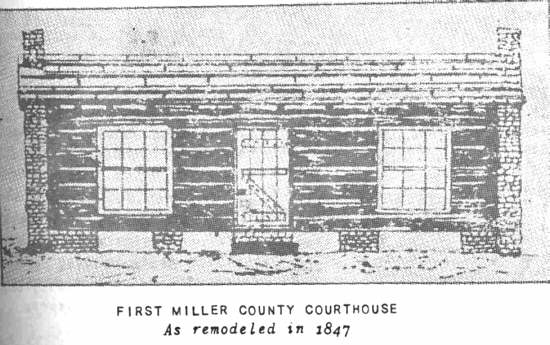 34 First Miller County Courthouse Well, the "repairs" to the courthouse were the most
fantastic ones you will ever see! The building was enlarged
from a 40 ft. by 56 ft. structure to one measuring 112 feet
long, 50 feet wide; walls 30 feet high; and a new tower or
cupola on top measuring 16 feet square, 25 feet high with a
metal covered dome adorned with a weather vane. A
Receptacle was built in the tower for a large clock; unfortunately, no clock was put there except the one
painted on each side with the hands pointing to 8 o'clock. In 1911 a Kansas City newspaper picked up the Story of Miller County's "repaired courthouse" and it was a wonderful story, although some citizens did not appreciate it very much.
The stone for the building was quarried from the bluffs of
the Osage River about a mile above Tuscumbia. The stone
masons proclaimed it to be the 'finest' stone for this kind of
work and much better than the common limestone. The
county ran out of money before the work was completed
and for quite sometime the county offices were moved out
and relocated in the Tuscumbia Bank Building. It wasn't
until in June of 1913 that a bond proposal was finally
accepted and carried by a two-thirds majority. Miller
County had a shell for a courthouse for almost three years.
Today the courthouse is standing high atop a hill in
Tuscumbia on a bluff overlooking the beautiful Osage River
Below (photo 30 above). It is one of the more beautiful sights in central Missouri. In the summer, the peaceful waters of the Osage rush northeastward adorned by green, fertile fields of corn and grain. In the wintertime, after a snowfall, there are no words known which could adequately describe the beauty of this Osage River Country as you stand on Courthouse Square and look up river at this majestic sight created by the hand of God.
As one walks into the courthouse today, remember that
within those inner chambers of the court rooms, both
upstairs and down, there are walls that have withstood the
pages of time and have seen generations of Miller
Countians pass through their hallways since 1859!
Thanks Peggy. After reading Peggy's essay one understands why those of us who love the traditions of our home county hate to see the old building waste away.
That's all for this week. We are decorating already for our Christmas Pot Luck Dinner Sunday December 9. Entertainment is planned which will be announced later.
Our fundraising efforts are ongoing as is our invitation for volunteers especially for next season. You can contact us at 573 369 3500 and leave a message.
Donations to the fundraising effort can be sent to:
Miller County Building Fund
P.O. Box 57
Tuscumbia, Mo. 65082
That's all for this week.
| 


